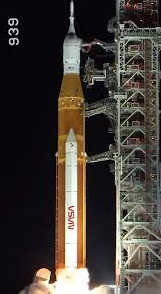
How the Space Launch System compares to Apollo’s Saturn V in power, design, and mission goals.
NASA is set to launch the most powerful rocket ever built, the Space Launch System (SLS), as part of the Artemis I mission on 29 August. Departing from Kennedy Space Center in Florida, the mission will test the SLS and the Orion spacecraft, marking the first step in NASA’s plan to return humans to the Moon by 2025.
The SLS, NASA’s modern heavy-lift rocket, combines features of the Space Shuttle and the Saturn V, which carried Apollo astronauts to the Moon over 50 years ago. While similar in purpose, the two rockets differ significantly in design, capabilities, and cost.
The Saturn V, the most powerful rocket until now, was first launched in 1967 and supported Apollo missions, including Apollo 11, which landed the first humans on the Moon in 1969. Standing 363 feet tall and weighing 6.5 million pounds, it produced 7.6 million pounds of thrust. The rocket had three stages and also launched NASA’s first space station, Skylab, in 1973.
In comparison, the SLS stands slightly shorter at 322 feet and weighs 5.5 million pounds. Despite this, its Block 1 configuration generates 8.8 million pounds of thrust, making it more powerful than the Saturn V. The SLS also utilises two solid rocket boosters, reminiscent of the Space Shuttle design, and has two stages instead of three. Future iterations will deliver even greater thrust.
Both rockets are non-reusable, unlike modern commercial rockets like SpaceX’s Falcon 9. However, the SLS benefits from technological advancements, featuring updated systems to support the more ambitious Artemis programme.
Artemis I will send the uncrewed Orion spacecraft on a 42-day journey around the Moon to test its systems and re-entry capabilities. If successful, Artemis II will conduct a crewed lunar flyby in 2024, followed by Artemis III in 2025, which will land astronauts on the Moon for the first time since 1972.
Cost remains a key difference. Adjusted for inflation, the Saturn V cost $1.5 billion per launch, with development totalling $51.8 billion. The SLS, however, costs an estimated $4.1 billion per launch, reflecting the expense of cutting-edge technology and its development.
The Artemis programme represents a new era in space exploration, leveraging lessons from Apollo to advance humanity’s reach. With Artemis III, NASA aims to achieve another historic milestone—returning humans to the Moon’s surface.












